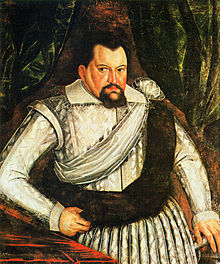Loading AI tools
Elector of Brandenburg from 1608 to 1619 From Wikipedia, the free encyclopedia
John Sigismund (German: Johann Sigismund; 8 November 1572 – 23 December 1619) was a Prince-elector of the Margraviate of Brandenburg from the House of Hohenzollern. He became the Duke of Prussia through his marriage to Duchess Anna, the eldest daughter of Duke Albert Frederick of Prussia who died without sons. Their marriage resulted in the potential creation of Brandenburg-Prussia, which became a reality after Poland's leader appointed John Sigismund in charge of Prussia in regency and, shortly thereafter, Albert Frederick died without an able, direct male heir.
This article needs additional citations for verification. (April 2017) |
| John Sigismund | |
|---|---|
 Portrait (unknown artist, c. 1610) | |
| Elector of Brandenburg | |
| Reign | 18 July 1608 – 23 December 1619 |
| Predecessor | Joachim Frederick |
| Successor | George William |
| Duke of Prussia | |
| Reign | 28 August 1618 – 23 December 1619 |
| Predecessor | Albert Frederick |
| Successor | George William |
| Duke of Cleves Count of Mark Count of Ravensburg | |
| Reign | 11 November 1614 – 23 December 1619 |
| Predecessor | John William |
| Successor | Incorporated into Brandenburg |
| Born | 8 November 1572 Halle, Archbishopric of Magdeburg, Holy Roman Empire |
| Died | 23 December 1619 (aged 47) Berlin, Electorate of Brandenburg, Holy Roman Empire |
| Burial | |
| Spouse | |
| Issue more... |
|
| House | Hohenzollern |
| Father | Joachim Frederick, Elector of Brandenburg |
| Mother | Catherine of Brandenburg-Küstrin |
| Religion | Lutheran (until 1613) Calvinist (since 1613) |
| Signature | |
John Sigismund was born in Halle an der Saale to Joachim III Frederick, Elector of Brandenburg, and his first wife Catherine of Brandenburg-Küstrin. He succeeded his father as Margrave of Brandenburg in 1608. In 1611, John Sigismund traveled from Königsberg to Warsaw, where on 16 November 1611 he gave feudal homage to Sigismund III Vasa, King of Poland (the Duchy of Prussia was a Polish fief at the time). He officially became Duke of Prussia in 1618, although he had served as regent on behalf of the mentally-disturbed Albert Frederick, Duke of Prussia, for several years prior. He suffered a stroke in 1616 from which he didn't recover and died in 1619.
John Sigismund gave the Reichshof Castrop to his teacher and educator Carl Friedrich von Bordelius. Through his wife, he became a major claimant in the War of the Julich Succession. He received the territories of Cleves, Mark, and Ravensberg in the Treaty of Xanten in 1614.
John Sigismund's most significant action was his conversion from Lutheranism to Calvinism, after he had earlier equalized the rights of Catholics and Protestants in the Duchy of Prussia under pressure from the King of Poland. He was probably won over to Calvinism during a visit to Heidelberg in 1606, but it was not until 25 December 1613 that he publicly took communion according to the Calvinist rite. The vast majority of his subjects in Brandenburg, including his wife Anna of Prussia, remained deeply Lutheran, however. After the Elector and his Calvinist court officials drew up plans for mass conversion of the population to the new faith in February 1614, as provided for by the rule of Cuius regio, eius religio within the Holy Roman Empire, there were serious protests, with his wife backing the Lutherans. Resistance was so strong that in 1615, John Sigismund backed down and relinquished all attempts at forcible conversion. Instead, he allowed his subjects to be either Lutheran or Calvinist according to the dictates of their own consciences. Henceforward, Brandenburg-Prussia would be a bi-confessional state.[1]
On 30 October 1594, John Sigismund married Anna of Prussia, daughter of Albert Frederick, Duke of Prussia (1553–1618). She was the elder sister of his stepmother. They were parents to eight children:
| Ancestors of John Sigismund, Elector of Brandenburg | |||||||||||||||||||||||||||||||||||||||||||||||||||||||||||||||||||||||||||||||||||||||||||||||||||||||||||||||||||||||||||||||||||||||||||||||||||||||||||||||||||||||||||||||||||||||||||||||||||||||||||||||||||||||||||||||||||||||||||||||||||||||||||||||||||||||||||||||||||||||||
|---|---|---|---|---|---|---|---|---|---|---|---|---|---|---|---|---|---|---|---|---|---|---|---|---|---|---|---|---|---|---|---|---|---|---|---|---|---|---|---|---|---|---|---|---|---|---|---|---|---|---|---|---|---|---|---|---|---|---|---|---|---|---|---|---|---|---|---|---|---|---|---|---|---|---|---|---|---|---|---|---|---|---|---|---|---|---|---|---|---|---|---|---|---|---|---|---|---|---|---|---|---|---|---|---|---|---|---|---|---|---|---|---|---|---|---|---|---|---|---|---|---|---|---|---|---|---|---|---|---|---|---|---|---|---|---|---|---|---|---|---|---|---|---|---|---|---|---|---|---|---|---|---|---|---|---|---|---|---|---|---|---|---|---|---|---|---|---|---|---|---|---|---|---|---|---|---|---|---|---|---|---|---|---|---|---|---|---|---|---|---|---|---|---|---|---|---|---|---|---|---|---|---|---|---|---|---|---|---|---|---|---|---|---|---|---|---|---|---|---|---|---|---|---|---|---|---|---|---|---|---|---|---|---|---|---|---|---|---|---|---|---|---|---|---|---|---|---|---|---|---|---|---|---|---|---|---|---|---|---|---|---|---|---|---|---|---|---|---|---|---|---|---|---|---|---|---|---|---|---|---|---|
| |||||||||||||||||||||||||||||||||||||||||||||||||||||||||||||||||||||||||||||||||||||||||||||||||||||||||||||||||||||||||||||||||||||||||||||||||||||||||||||||||||||||||||||||||||||||||||||||||||||||||||||||||||||||||||||||||||||||||||||||||||||||||||||||||||||||||||||||||||||||||
Seamless Wikipedia browsing. On steroids.
Every time you click a link to Wikipedia, Wiktionary or Wikiquote in your browser's search results, it will show the modern Wikiwand interface.
Wikiwand extension is a five stars, simple, with minimum permission required to keep your browsing private, safe and transparent.